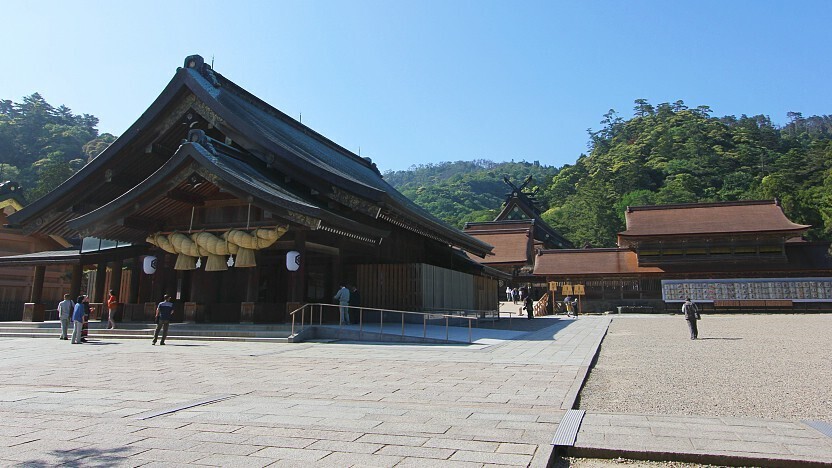
Izumo Taisha (Åoē_æÕÄą) is one of Japan's most important shrines, located in Izumo, Shimane Prefecture, a one hour train ride west of Matsue. There are no records of exactly when Izumo Taisha was built, but it is often considered the oldest shrine in Japan, being already in existence in the early 700s as revealed by the nation's oldest chronicles.
Izumo used to be ruled by a powerful clan in pre-historic times, and the region plays a central role in Japan's creation mythology. The main deity (kami) enshrined at Izumo Taisha is Okuninushi no Okami. According to the creation myths, Okuninushi was the creator of the land of Japan and the ruler of Izumo. He also became known as the deity of good relationships and marriage. Visitors consequently clap their hands four times instead of the usual two times during their prayers: twice for themselves and twice for their actual or desired partners.
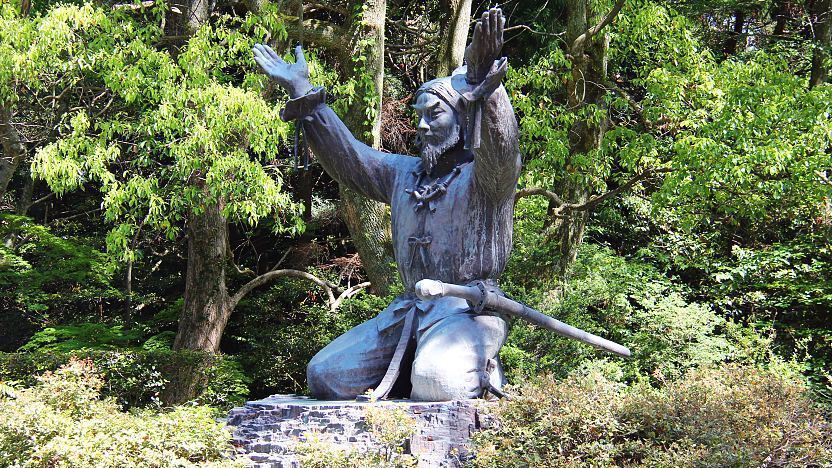
Every year, from the 10th to the 17th day of the 10th lunar month (falls usually in November), all of Shinto's deities from across the land gather at Izumo Taisha for a meeting. It is for this reason that the 10th lunar month is known as Kamiarizuki ("month with deities") in Izumo, and Kannazuki ("month without deities") everywhere else in Japan. As per tradition, the Kamiari Festival is held at the shrine during this period.
The main approach to the shrine starts at a giant torii gate and a shopping street lined by stores and restaurants. At the end of the street stands a large wooden torii gate, which marks the entrance to the actual shrine grounds. Continuing north, the approach uniquely leads downhill for a few dozen meters, leading to the Matsu no Sando where the trail is divided into three lanes by two rows of pine trees. Visitors are to refrain from taking the center lane, as it is said to be the path reserved for the deities.
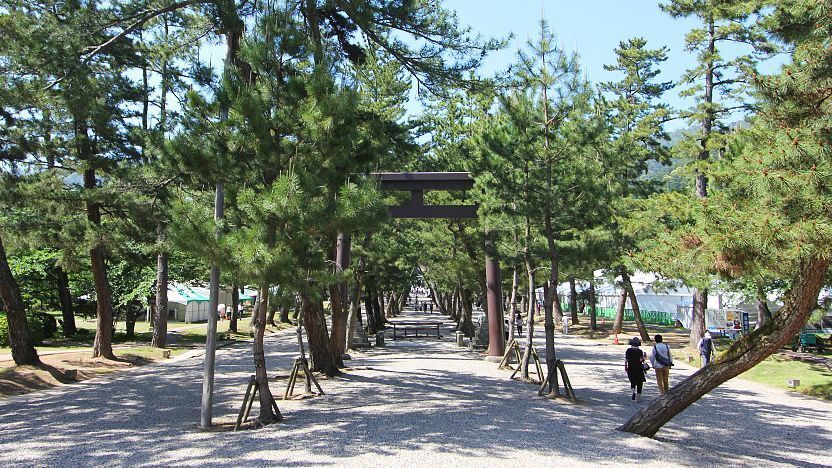
Going past the pine trees finally leads to a bronze torii gate, the entrance to the main shrine grounds. Immediately upon entry, visitors will be confronted by a beautiful wooden structure with a huge sacred straw rope (shimenawa) hung across half its length. This is the Worship Hall (Haiden). The shimenawa indicates the presence of a deity and separates divine space from the mortal realm. Large shimenawa are a characteristic of the Izumo region, found also at other shrines in the area.
Behind the worship hall stands the Main Hall (Honden) at 24 meters tall, making it the tallest shrine building in Japan. Interestingly, it used to be even considerably taller in the past, perched on large pillars. The current structure was built in 1744 in a purely Japanese architectural style called Taisha-zukuri, which predates the arrival of Buddhism to Japan and the non-native influences it had on shrine architecture.
The main hall together with a few smaller shrine buildings are surrounded by two sets of fences which demarcate inner sanctuaries not accessible to general visitors. It is however possible to walk around the outer fence and view several more shrine buildings around it. Among them are two long wooden structures on both sides of the main sanctuary, called Jukusha, which serve as the lodgings for all the deities when they assemble at the shrine for their annual meeting.
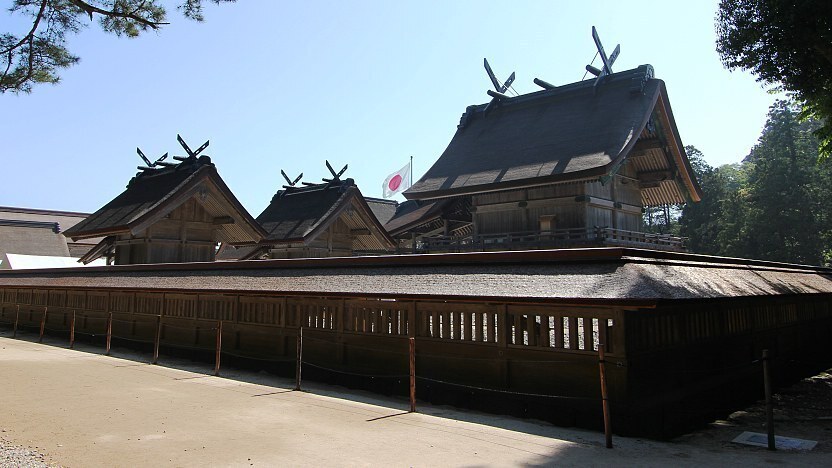
Until 1744, Izumo Taisha used to be periodically rebuilt like the Ise Shrines. Since then, the tradition has been only partially maintained with major renovations instead of full rebuildings carried out once approximately every 60 years. The most recent such renovation began in 2008 and was mostly completed in spring 2013 when the construction scaffolding around the main hall was removed and the deity moved back into the building.
At the southeastern corner of the main shrine grounds stands a treasure hall which exhibits paintings, documents and lavishly ornamented containers, as well as a model and artist impressions of how Izumo Taisha might have looked in the past when it stood on tall pillars. Immediately east of the shrine grounds stands the Shimane Museum of Ancient Izumo where visitors can learn even more about the shrine and the Izumo region.
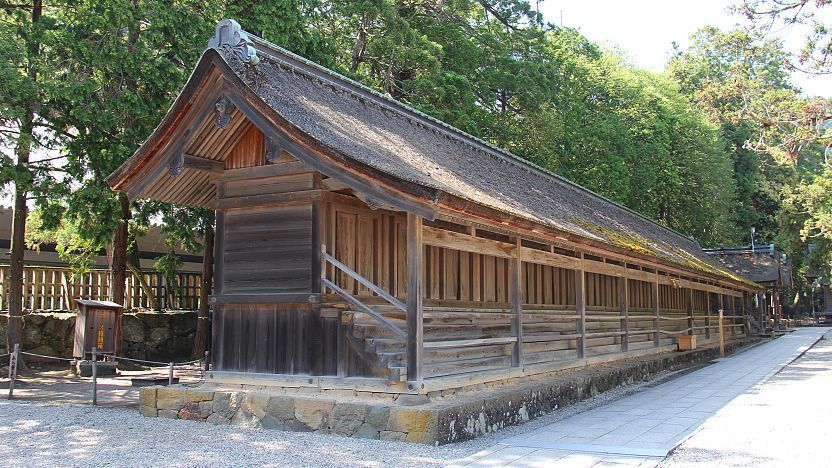
Getting there and around
From Izumoshi Station
Izumo Taisha is located several kilometers north of Izumoshi Station. They are connected with each other by direct buses and the Ichibata Railway:
Buses depart from Izumoshi Station roughly every 30 minutes and stop at Dentetsu-Taisha-eki (at the Izumo Taisha-mae Station along the shopping street leading to the shrine, 470 yen one way), Seimon-mae (at the entrance to the main grounds, 510 yen one way) and at the Izumo Taisha Bus Terminal (to the west of the main grounds, 530 yen one way). The ride takes roughly half an hour.
By Ichibata Railway, the shrine can be reached in about 20 minutes and for 500 yen one way. A transfer of trains is required at Kawato Station along the way. The shrine is a five minute walk from the terminal station, Izumo Taisha-mae Station.
From Matsue
From Matsue, Izumo Taisha is most easily reached by Ichibata Railway. Trains leave from Matsue Shinjiko Onsen Station and require about one hour to reach the shrine. One transfer of trains is required at Kawato Station. The one way fare is 820 yen. For a round trip, a one day pass for unlimited use of Ichibata trains for 1600 yen pays off.
An alternative route would be taking a JR train from Matsue to Izumoshi Station (25-40 minutes) and then proceed to the shrine from there (see details above). This option is somewhat cheaper for Japan Rail Pass holders.
How to get to and around Izumo
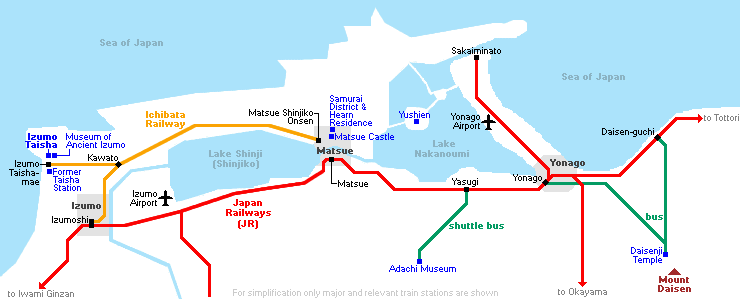
Hours and Fees
Izumo Taisha Shrine
Hours
Closed
Admission
Treasure Hall
Hours
Closed
Admission
Questions? Ask in our forum.